
Activity levels are starting to recover following large drops caused by coronavirus (Covid-19) pandemic restrictions, Sport England’s latest Active Lives Adult Survey report shows.
Covering the period between November 2020 and November 2021, the results, which have been published today, show that while activity levels obviously dropped as a result of restrictions designed to stop the spread of the virus, they then stabilised and are now starting to recover.
Between November 2020 and November 2021, 61.4% of the population were active, and 27.2% were inactive. The recovery started in mid-March 2021 when there was a rise of 3% to 61.2% of the population getting active (between mid-March – mid-May), compared to just 58.2% 12 months earlier.
While numbers are still down compared to pre-pandemic, with 600k (1.9%) fewer active adults and 1.3m (2.6%) more inactive adults, the recovery is a testament to the work and investment that went into helping people stay active during a period of unprecedented restrictions.
However, while this initial recovery is good news, the data shows that this is not universal, with many people struggling, a trend that emerged before the pandemic and which is why Sport England’s strategy, Uniting the Movement, has such a strong focus on tackling inequalities and barriers.
When restrictions were lifted in July 2021, the number of people saying they felt they had the opportunity to be active increased close to levels we saw pre the emergence of coronavirus.
Team sports participation numbers bounced back close to pre-pandemic levels, following large drops during restrictions. Football (+2% across mid-July – mid-September 2021), cricket (+0.3% mid-July – mid-September 2021) and basketball (+0.3% mid-September – mid-November 2021) in particular have seen large numbers of returners which is driving the overall recovery in team sports.
There is positive news for older people with recovery to pre-pandemic levels seen in activity levels for those aged 55-74 and 75+ while the report is also clear which audiences continue to struggle.
We continue to work closely with partners across the sport and physical activity landscape, not just to drive demand and increase participation, but also to ensure the long-term viability of the sector through a focus on work in areas like safeguarding, coaching, governance and leadership development.
Overall population numbers hide stark inequalities with women, those from ethnically diverse communities, those living in more deprived areas, disabled people and people with long-term health conditions still less likely to be active than others, and the pandemic has exacerbated the inequalities for the least affluent, Asian people, disabled people and people with long-term health conditions in particular.
The gap in activity levels between the haves and have nots has also widened during the pandemic, with those that live in deprived areas seeing bigger drops in activity levels than those in more well-off areas. For example, activity fell 4.4% for those living in the most deprived areas (IMD 1-3) compared to pre-pandemic compared to a 1.2% for those in the least deprived areas (IMD 8-10).
While initial drops have stabilised for most groups, activity levels for the younger adults (16-34) have continued to fall at a worrying rate, continuing a downward trend that started before the pandemic. As the sport and physical activity sector recovers from coronavirus, it’s vital that activity offerings appeal to this younger generation so they can benefit from the profound health, social and personal benefits that being active brings.